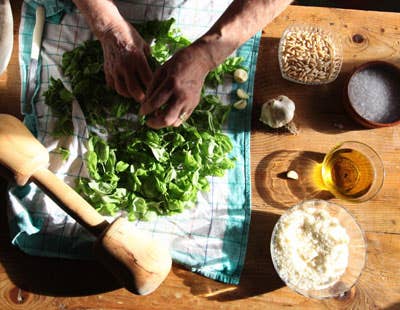
Elements of Pesto
Since traditional pesto genovese consists of nothing more than basil, garlic, nuts, olive oil, salt, and cheese, the quality and variety of the ingredients you choose really matter. When it comes to basil, shop for the youngest herbs you can find, with the smallest, palest leaves. The smell should be aromatic, not licorice-like. If you can't find young basil, soften the bitterness of deep green mature leaves by blanching them in almost boiling water for 30 seconds, then plunge them in an ice bath. Youth is also important when it comes to garlic—the younger it is, the sweeter and juicier it will be. Italian-grown pignoli are ideal for their round, rich flavor, but they're expensive. Imported Chinese pine nuts are cheaper and acceptable, though walnuts, soaked in very hot water for at least an hour to release any acrid notes, are a better substitute. Coarse grained salt should be used to help pulverize the ingredients; rather than kosher salt, use sea salt, which imparts a subtle briny flavor akin to what you find in authentic pesto genovese. Liguria's local olive oil, made with tiny taggiasca olives, is a perfect match for pesto: It has a pale gold color and a delicate, slighty saline flavor. Avoid overly fruity or sharp oils that will overpower the sauce. As for cheese, nowadays Parmigiano-Reggiano, ideally aged at least 24 months, is preferred for its rich, nutty taste, but it's traditional to add percorino, a sharp, salty sheep's milk cheese, from Sardinia or Southern Italy, to round out the pesto's flavor.
Keep Reading
Continue to Next Story










